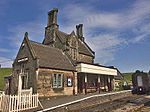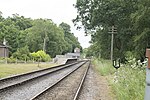Churnet Valley Railway

The Churnet Valley Railway is a preserved standard gauge heritage railway in the Staffordshire Moorlands of Staffordshire, England. It operates on part of the former Churnet Valley Line.which was opened by the North Staffordshire Railway. The railway is roughly 10.5 miles (16.9 km) long from Kingsley and Froghall to Ipstones. The land from Leek Brook Junction to Ipstones was opened by Moorland & City Railways (MCR) in 2010 after they took a lease out from Network Rail. This has subsequently been purchased by the Churmet Valley Railway. The main stations along the line are Kingsley and Froghall, Consall, Cheddleton and Leek Brook (which is only used as a run around loop). Work has begun to extend the line to the town of Leek which will act as the northern terminus of the line. The line between Leek and Waterhouses has also been reopened as part of the heritage railway far as Ipstones.
Excerpt from the Wikipedia article Churnet Valley Railway (License: CC BY-SA 3.0, Authors, Images).Churnet Valley Railway
Apesford Lane, Staffordshire Moorlands Cheddleton
Geographical coordinates (GPS) Address Nearby Places Show on map
Geographical coordinates (GPS)
| Latitude | Longitude |
|---|---|
| N 53.064444444444 ° | E -2.0263888888889 ° |
Address
Railway Yard
Apesford Lane
ST13 7EG Staffordshire Moorlands, Cheddleton
England, United Kingdom
Open on Google Maps








